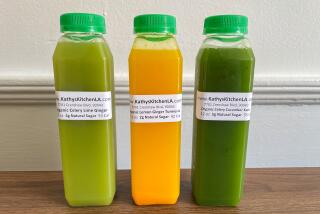It’s time fruit juice loses its wholesome image, some experts say
- Share via
To many people, it’s a health food. To others, it’s simply soda in disguise.
That virtuous glass of juice is feeling the squeeze as doctors, scientists and public health authorities step up their efforts to reduce the nation’s girth.
FOR THE RECORD:
Fruit juice: An article in the Nov. 8 Section A about the health effects of drinking 100% fruit juice quoted UC Davis scientist Kimber Stanhope as saying that her studies suggest fructose, a type of sugar, would increase risk factors for cardiovascular disease and Type 2 diabetes equally whether it was consumed in soda or in juice. Stanhope said that overconsumption of soda or 100% fruit juice would probably promote similar weight gain, one risk factor for heart disease and diabetes. However, she did not mean to imply that consumption of fructose from soda versus juice would have equal effects on other risk factors, such as increased blood triglyceride levels and decreased insulin sensitivity. She believes it is possible —though unproven -- that other components of juice may protect against those effects.
It’s an awkward issue for the schools that peddle fruit juice in their cafeterias and vending machines. It’s uncomfortable for advocates of a junk-food tax who say they can’t afford to target juice and alienate its legions of fans. It’s confusing for consumers who think they’re doing something good when they chug their morning OJ, sip 22-ounce smoothies or pack apple juice in their children’s lunches.
The inconvenient truth, many experts say, is that 100% fruit juice poses the same obesity-related health risks as Coke, Pepsi and other widely vilified beverages.
With so much focus on the outsized role that sugary drinks play in the country’s collective weight gain -- and the accompanying rise in conditions including diabetes, heart disease and cancer -- it’s time juice lost its wholesome image, these experts say.
“It’s pretty much the same as sugar water,” said Dr. Charles Billington, an appetite researcher at the University of Minnesota. In the modern diet, “there’s no need for any juice at all.”
A glass of juice concentrates all the sugar from several pieces of fruit. Ounce per ounce, it contains more calories than soda, though it tends to be consumed in smaller servings. A cup of orange juice has 112 calories, apple juice has 114, and grape juice packs 152, according to the U.S. Department of Agriculture. The same amount of Coke has 97 calories, and Pepsi has 100.
And just like soft drinks, juice is rich in fructose -- the simple sugar that does the most to make food sweet.
UC Davis scientist Kimber Stanhope has found that consuming high levels of fructose increases risk factors for heart disease and Type 2 diabetes because it is converted into fat by the liver more readily than glucose. Her studies suggest that it doesn’t matter whether the fructose is from soda or juice.
“Both are going to promote equal weight gain,” she said, adding that she’s perplexed by the fixation on the evils of sugar-sweetened beverages: “Why are they the only culprit?”
OJ for the masses
Juice is a relatively recent addition to the human diet. For thousands of years, people ate fruit and drank mostly water.
But in the early 1900s, citrus growers in Florida were harvesting more oranges than they could sell. Then they had an epiphany: promote juice.
“You consume more oranges if you drink them than if you eat them whole,” said Alissa Hamilton, author of the book “Squeezed: What You Don’t Know About Orange Juice.”
The U.S. Army was instrumental in turning orange juice into a commercial product.
It originally served a powdered lemonade to ensure soldiers got enough vitamin C, but it tasted “like battery acid,” Hamilton said. So, during World War II, the Army commissioned scientists to invent a system for freezing OJ in a concentrated form. The patent wound up with Minute Maid, which sold cans of frozen juice concentrate in grocery stores.
In the 1950s, pasteurization technology developed by Tropicana made orange juice even more consumer-friendly because it could be sold ready to drink in cartons, like milk.
TV fitness pioneer Jack LaLanne and other health experts touted juice as a natural medicine, and decades of advertising helped secure its place at the breakfast table. Today, roughly half of all Americans consume juice regularly, according to NPD Group, a market research firm.
The Juice Products Assn. emphasizes the value of the vitamins, minerals and phytonutrients in juice, especially when so many Americans eat so little fresh produce.
“If someone can add a glass of fruit juice at breakfast, that’s an important addition to the diet,” said Sarah Wally, a dietitian for the trade group.
But scientists are increasingly questioning whether the benefits outweigh the sugar and calories that come with them. “The upside of juice consumption is so infinitesimal compared to the downside that we shouldn’t even be having this discussion,” said Dr. Robert Lustig, a pediatric endocrinologist at UC San Francisco.
Weight factor
Researchers haven’t published head-to-head comparisons of how juice and soda contribute to weight gain, but there is evidence that high juice consumption increases the risk of becoming overweight or obese, especially among kids.
One of the earliest studies, in 1997, examined 168 preschool-age children in upstate New York. Kids who drank at least 12 ounces of juice a day were 3 1/2 times more likely than other kids to exceed the 90th percentile for body mass index, qualifying them as overweight or obese.
A 2006 study of 971 low-income youngsters found that each extra glass of juice a day caused children who were already overweight or obese to gain an extra pound each year.
The link between juice and weight gain isn’t always found, however. In a 2008 review of 21 studies, six supported the connection and 15 did not.
In fact, several researchers have linked juice to healthier diets and lower weights. A 2008 report of 3,618 children ages 2 to 11 found that kids who drank at least 6 ounces of juice a day consumed less fat and more vitamins and minerals than kids who drank no juice at all.
But many experts say the data simply reflect a correlation between juice and healthful diets, not a causal relationship.
“Kids who drink more juice are more likely to be eating breakfast, and kids who eat breakfast tend to weigh less than kids who don’t,” said Kelly Brownell, director of the Rudd Center for Food Policy and Obesity at Yale University.
There’s also concern that children who drink lots of sweet beverages such as juice will develop a lifelong preference for sweeter foods. A 2004 Dutch study found that 8- to 10-year-olds preferred sweeter drinks after consuming a sugary orangeade for eight days. They also drank more of it as they acclimated to its sweet taste.
Doctors and health officials have been persuaded to de-emphasize juice in recent years.
The American Academy of Pediatrics’ nutrition committee revised its policy in 2001 to recommend that children ages 1 to 6 drink no more than one 4- to 6-ounce serving of juice a day and older kids have no more than two.
“Because juice is viewed as nutritious, limits on consumption are not usually set by parents,” the committee wrote in “The Use and Misuse of Fruit Juice in Pediatrics.” “Like soda, it can contribute to energy imbalance,” causing the weight gain that leads to obesity.
The government’s 2005 dietary guidelines recognize that juices can be good sources of potassium, but recommend whole fruit for the majority of daily fruit servings to ensure adequate intake of fiber.
In October, the federal Special Supplemental Nutrition Program for Women, Infants and Children introduced vouchers for fresh produce and reduced the juice allowance. That’s a change Billington and his colleagues in the Minnesota Medical Assn. had been pushing for since 2006.
“Having apple juice and eating an apple are not the same,” he said.
Concentrated sugar
Indeed, as scientists zero in on the causes of rising obesity rates, sugary drinks have emerged as a primary culprit.
Calories consumed in liquid form don’t give stomachs the same satisfied feeling as calories eaten in food. People offset an afternoon snack by eating less at dinner, but they don’t do that with beverages.
“The studies are pretty clear,” said Dr. Barbara Dennison, a research and policy director at the New York State Department of Health in Albany. “You just don’t compensate for those calories.”
Making matters worse, the human body is ill-equipped to process the sugar that is concentrated in a glass of juice.
When fructose is eaten in a piece of fruit, it enters the body slowly so the liver has time to convert it into chemical energy. But a single glass of apple juice has the fructose of six apples.
“If you overdose on fructose in a liquid, the liver gets overwhelmed,” Lustig said. As a result, he said, the fructose turns to fat. “Eating fruit is fine. Drinking juice is not.”
Still, the halo surrounding juice remains strong.
As soda is singled out for its role in the rise of obesity, juice is offered as the sensible alternative. In Los Angeles and elsewhere, it is taking the place of soft drinks in school vending machines alongside water and milk.
Brownell of Yale has waged a high-profile campaign to fight obesity with “sin” taxes on soda and other sugary drinks. It’s already an uphill battle, and he said he’s loath to provoke the tens of millions of Americans who consider their morning juice sacrosanct.
Dr. Frank Greer, who spent 10 years on the American Academy of Pediatrics’ nutrition committee, said he “can’t imagine” the group would ever downgrade juice to the status of soda.
“It’s such a normal part of the American diet,” Greer said. “A glass of fresh-squeezed orange juice for breakfast, my goodness!”
More to Read
Sign up for Essential California
The most important California stories and recommendations in your inbox every morning.
You may occasionally receive promotional content from the Los Angeles Times.










